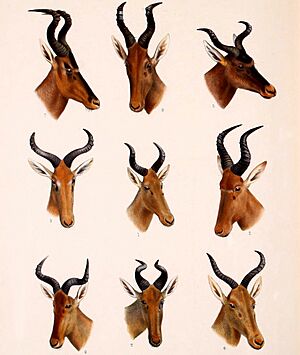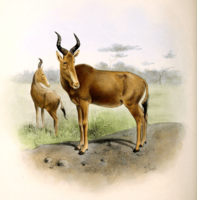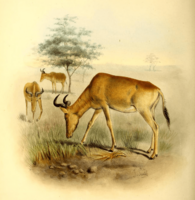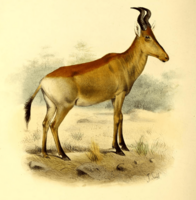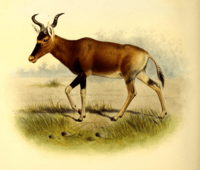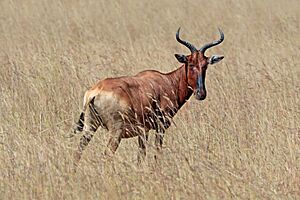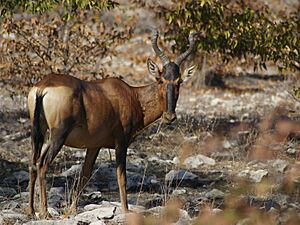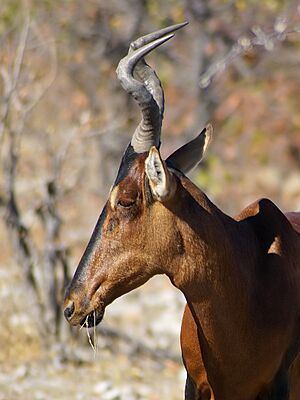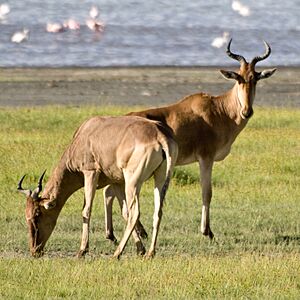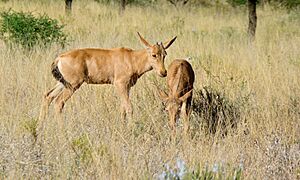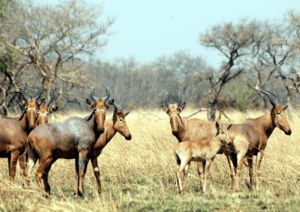Hartebeest facts for kids
Quick facts for kids Hartebeest |
|
|---|---|
 |
|
| Coke's hartebeest in the Serengeti National Park, Tanzania | |
| Conservation status | |
| Scientific classification | |
| Subspecies | |
|
List
|
|
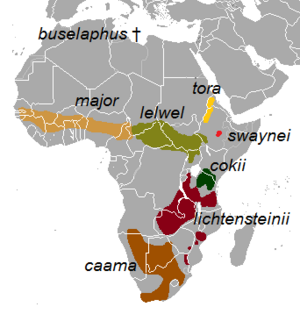 |
|
| Distribution of the subspecies | |
| Synonyms | |
|
The hartebeest (pronounced HART-uh-beest), also called kongoni or kaama, is an African antelope. It is the only type of animal in its group, Alcelaphus. There are eight different kinds, or subspecies, of hartebeest. Some people even think two of these are their own separate species.
Hartebeests are large antelopes. They stand over 1 meter (3 feet) tall at the shoulder. Their body length is usually 2 to 2.5 meters (6.5 to 8 feet). They weigh between 100 and 200 kilograms (220 to 440 pounds). Hartebeests have a very long face and unusual horns. They also have a short neck and pointy ears. Their legs are long and sometimes have black marks. Their fur is short and shiny. The color of their fur changes depending on the subspecies. It can be sandy brown or even chocolate brown. Both male and female hartebeests have horns. The females' horns are thinner. Horns can grow from 45 to 70 centimeters (18 to 28 inches) long. Besides their long face, hartebeests have a big chest and a back that slopes sharply. This helps tell them apart from other antelopes. They also have a noticeable hump over their shoulders.
Hartebeests are social animals. They live in herds of 20 to 300 individuals. They are very watchful and usually not aggressive. They mostly eat grass. Hartebeests can mate all year round. The best times for mating depend on the subspecies and where they live. Both males and females can have babies when they are one or two years old. Pregnancy lasts for eight to nine months. After this, one calf is born. Most births happen in the dry season. Hartebeests usually live for 12 to 15 years.
Hartebeests live in dry savannas and grassy woodlands. They often move to drier places after it rains. They have been seen high up on Mount Kenya, at altitudes of 4,000 meters (13,000 feet). Hartebeests used to live all over Africa. But their numbers have dropped a lot. This is because their homes are being destroyed. People also hunt them and build towns where they live. They also have to compete with farm animals for food. Each of the eight subspecies has a different conservation status. The Bubal hartebeest was declared extinct in 1994. The numbers of red hartebeest are growing. But the Tora hartebeest is Critically Endangered, and its numbers are still falling. Hartebeests no longer live in Algeria, Egypt, Lesotho, Libya, Morocco, Somalia, and Tunisia. But they have been brought to Eswatini and Zimbabwe. People like to hunt them for their meat.
Contents
What's in a Name?
The name "hartebeest" comes from an old Dutch word, hertebeest. This means "deer beast." Early Dutch settlers thought the antelope looked like a deer. The word "hartebeest" was first written down in 1660. It was in a journal by a Dutch official named Jan van Riebeeck. He wrote that someone had "shot one hartebeest." Another name for the hartebeest is kongoni. This is a Swahili word. Kongoni often refers to a specific kind of hartebeest, the Coke's hartebeest.
Hartebeest Family Tree
The scientific name for the hartebeest is Alcelaphus buselaphus. It was first described by a German zoologist named Peter Simon Pallas in 1766. It belongs to the group Alcelaphus and the family Bovidae. Scientists have studied hartebeests for many years. They look at things like skull shapes and MtDNA (genetic material). This helps them understand how different kinds of hartebeests are related. They also compare them to other animals like wildebeest and sassabies.
Hartebeest Subspecies
There are eight recognized subspecies of hartebeest. Two of these, A. b. caama and A. b. lichtensteinii, are sometimes thought to be separate species. However, genetic studies show they are part of the A. buselaphus group. This means they are still considered subspecies.
Here are the eight subspecies:
- † A. b. buselaphus (Pallas, 1766): This is the bubal hartebeest. It used to live all over northern Africa. But it became extinct by the 1920s. The International Union for the Conservation of Nature and Natural Resources (IUCN) declared it extinct in 1994.
- A. b. caama (Saint-Hilaire, 1803): This is the red hartebeest. It used to live in many parts of southern Africa. Now, it mainly lives in the Northern Cape, Botswana, and Namibia. Many red hartebeests have been brought back to these areas. Their numbers are now increasing.
- A. b. cokii (Günther, 1884): This is Coke's hartebeest or kongoni. It only lives in Kenya and northern Tanzania.
- A. b. lelwel (Heuglin, 1877): This is the Lelwel hartebeest. Its population has dropped a lot since the 1980s. Most of them now live in protected areas.
- A. b. lichtensteinii (Peters, 1849): This is Lichtenstein's hartebeest. It lives in the woodlands of eastern and southern Africa. It can be found in Angola, Congo, Malawi, Mozambique, South Africa, Tanzania, Zambia, and Zimbabwe.
- A. b. major (Blyth, 1869): This is the western hartebeest. It used to live in many West African countries. Now, there are fewer of them. They mainly live in protected areas. It might be extinct in Gambia.
- A. b. swaynei (Sclater, 1892): This is Swayne's hartebeest. It lives only in the southern Rift Valley in Ethiopia. It is an endangered species. Its numbers are low, but slowly increasing.
- A. b. tora (Gray, 1873): This is the tora hartebeest. It used to live in Ethiopia and Eritrea. Its current status is not clear.
- Five hartebeest subspecies
Hartebeest Genetics and Hybrids
Scientists study the genes of hartebeests. This helps them understand how different groups are related. For example, a study in 2000 looked at Swayne's hartebeest. It found that two groups of this subspecies were quite different genetically. This means they need careful conservation.
Hartebeests have 40 chromosomes. Sometimes, different subspecies mate where their homes overlap. This creates hybrids. For example, hybrids of Lelwel and Tora hartebeests have been seen in Sudan and Ethiopia. A hybrid between a red hartebeest and a blesbok was found to be sterile. This means it could not have babies.
There are three well-known hybrids:
- Alcelaphus lelwel x cokii: This is the Kenya Highland hartebeest. It's a mix of Lelwel and Coke's hartebeest. It is lighter in color and bigger than Coke's hartebeest. Both males and females have horns that are heavier and longer.
- Jackson's hartebeest: This is also thought to be a hybrid of Lelwel and Coke's hartebeest. It looks more like the Lelwel hartebeest in some areas. In other areas, it looks more like the Coke's hartebeest.
- Alcelaphus lelwel x swaynei: This is Neumann's hartebeest. It's a mix of Lelwel and Swayne's hartebeest. Its face is longer than Swayne's hartebeest. Its fur is golden brown. Both sexes have longer horns than Swayne's hartebeest.
How Hartebeests Evolved
The Alcelaphus group, which includes hartebeests, appeared about 4.4 million years ago. Scientists think hartebeests first came from eastern Africa. They quickly spread across the African savannas. Hartebeest populations split into two main groups about 0.5 million years ago. One group went north, and the other went south. The northern group then split into eastern and western groups. This happened about 0.4 million years ago. It was likely due to changes in the climate. The eastern group led to Coke's, Swayne's, Tora, and Lelwel hartebeests. The western group led to Bubal and western hartebeests. The southern group led to Lichtenstein's and red hartebeests. These two are closely related.
The oldest hartebeest fossils are about 0.7 million years old. Fossils of the red hartebeest have been found in South Africa and Zambia. Hartebeest remains have also been found in Israel. This shows they used to live outside of Africa too.
What Hartebeests Look Like
Hartebeests are large antelopes. They have a very long face and unusual horns. They stand over 1 meter (3 feet) tall at the shoulder. Their body length is usually 2 to 2.5 meters (6.5 to 8 feet). They weigh between 100 and 200 kilograms (220 to 440 pounds). Their tail is 40 to 60 centimeters (16 to 24 inches) long. It ends in a black tuft. Other special features are their long legs, short neck, and pointy ears.
The western hartebeest is the largest subspecies. It has a white line between its eyes. The red hartebeest is also big. It has a black forehead and a light band between its eyes. The Lelwel hartebeest has dark stripes on the front of its legs. Coke's hartebeest is medium-sized. It has a shorter forehead and a longer tail. Lichtenstein's hartebeest is smaller. It also has dark stripes on its legs. Swayne's and Tora hartebeests are smaller. They both have shorter foreheads.
Their fur is usually short and shiny. The color varies by subspecies. Western hartebeests are pale sandy-brown. Red hartebeests are reddish-brown with a dark face. Lelwel hartebeests are reddish tan. Coke's hartebeests are reddish to tawny. Lichtenstein's hartebeests are reddish brown with lighter flanks. Tora hartebeests are dark reddish brown on top. Swayne's hartebeests are a rich chocolate brown. Their hairs have white tips.
Both male and female hartebeests have horns. Female horns are thinner. Horns can be 45 to 70 centimeters (18 to 28 inches) long. The longest recorded horn was 74.9 centimeters (29.5 inches). This was from a Namibian red hartebeest. Western hartebeest horns are thick and U-shaped from the front. Red and Lelwel hartebeest horns are similar. Lichtenstein's hartebeest has thick, ringed horns. Swayne's hartebeest horns are thin and curve like parentheses. Tora hartebeest horns are very thin and spread out sideways.
Hartebeests have a long face, big chest, and a sharply sloping back. These features help tell them apart from other antelopes. They are similar to sassabies in some ways. Both sexes have horns and similar body sizes. Males are usually a bit heavier than females.
Hartebeest Life and Habits
Hartebeests are active mostly during the day. They eat grass in the early morning and late afternoon. Around noon, they rest in the shade. They are social animals and live in herds of up to 300. Even larger groups can gather where there is a lot of grass. However, these big groups often spread out. A herd has different groups: adult males with territories, other adult males, young males, and females with their young. Females form groups of 5 to 12. These groups can include four generations of young. Females will fight for control of the herd. Males try to take over a territory when they are three or four years old. A male defends his territory. He marks its edges by leaving droppings.
Hartebeests are very alert and careful animals. They are usually calm. But they can be fierce if they feel threatened. When they are eating, one hartebeest often stands guard. It might stand on a termite mound to see farther. If there is danger, the whole herd runs away in a single line. Adult hartebeests are hunted by lions, leopards, hyenas, and wild dogs. Cheetahs and jackals hunt young hartebeests. Crocodiles might also hunt them.
Hartebeests' long, thin legs help them run away quickly in open areas. If attacked, their strong horns help them fight off predators. Their eyes are high up on their heads. This lets them watch their surroundings while they eat. Their muzzle is shaped to get the most food from even small amounts of grass. Horns are also used when males fight for dominance during mating season. The sound of their horns clashing can be heard far away. Fights usually start with head movements and stances. They drop to their knees and wrestle, locking horns. They try to stab the other's neck or shoulders. Fights are rarely serious, but can sometimes be deadly.
Hartebeests make quiet quacking and grunting sounds. Young hartebeests are louder than adults. They make a quacking call when scared. Hartebeests use their droppings to mark their territory. Herds usually stay in one place. They only move if there are bad conditions, like natural disasters. Hartebeests are the least migratory of their group. They also need less water and have a slower metabolism than wildebeest and sassabies.
Hartebeest Health
Hartebeests can get various parasites and diseases. Some parasites can cause serious illnesses. However, parasites are not always harmful. For example, many larvae were found in one hartebeest's head, but it was not sick. Hartebeests can also get different types of worms.
What Hartebeests Eat
Hartebeests mostly eat grass. Their skull structure helps them eat and chew tough, fibrous plants. They eat less food than other animals in their group. Their long, thin muzzle helps them eat short grass blades. It also helps them nibble leaves from grass stems. They can even get good nutrition from tall, old grasses. These adaptations help hartebeests find food even in the dry season. This is a hard time for many grazers. These special abilities might have helped hartebeests spread across Africa millions of years ago.
Grass makes up at least 80 percent of their diet. In the wet season (October to May), it's over 95 percent. They also eat some other plants. Hartebeests can digest more food than topi and wildebeest. In places with little water, they can eat melons, roots, and tubers. Hartebeests are picky eaters. They prefer certain types of grass. They eat more different grass species in the dry season.
Hartebeest Reproduction
Hartebeests can mate all year. There might be one or two peak times. This depends on how much food is available. Both males and females can have babies when they are one or two years old. Mating happens in areas defended by a single male. Males may fight fiercely for dominance. Any other male that enters is chased away. In large herds, females often mate with several males.
Pregnancy lasts for eight to nine months. Then, a single calf is born. It weighs about 9 kilograms (20 pounds). Most births happen in the dry season. Calves are usually born in thickets. This is different from wildebeest, who give birth in groups on open plains. Calves can walk soon after birth. But they usually lie in the open near their mothers. Calves stop drinking milk at four months old. Young males stay with their mothers for two and a half years. This is longer than other animals in their group. Young males often have a high death rate. This is because adult males are aggressive towards them. They also don't get as much good food. Hartebeests usually live for 12 to 15 years.
Hartebeest Homes
Hartebeests live in dry savannas, open plains, and grassy woodlands. They often move to drier places after it rains. They can live in more wooded areas than other animals in their group. They are often found at the edge of forests. Hartebeests have been seen high up on Mount Kenya, at altitudes of 4,000 meters (13,000 feet). Red hartebeests can travel across large areas. Females can roam over 1,000 square kilometers (386 square miles). Male territories are about 200 square kilometers (77 square miles). In Nairobi National Park, female home ranges are 3.7 to 5.5 square kilometers (1.4 to 2.1 square miles). These ranges are big enough to include 20 to 30 male territories.
Hartebeest Conservation Status
The International Union for Conservation of Nature (IUCN) lists each hartebeest subspecies with a different conservation status. The species as a whole is listed as Least Concern. This means it is not currently at high risk. However, hartebeests are now extinct in Algeria, Egypt, Lesotho, Libya, Morocco, Somalia, and Tunisia.
- The Bubal hartebeest has been extinct since 1994. Hunting and human activity caused its numbers to drop. The last one was shot in Algeria in 1925.
- Coke's hartebeest is listed as Least Concern. Its habitat is being destroyed. About 42,000 Coke's hartebeests live in parks in Tanzania and Kenya. Their population is decreasing. Most of them live in protected areas.
- The Lelwel hartebeest is listed as Endangered. Its numbers have dropped a lot since the 1980s. Fewer than 70,000 individuals are left. Most of them are now in protected areas.
- Lichtenstein's hartebeest is listed as Least Concern. It lives in protected areas and the wild in Tanzania and Zambia.
- The red hartebeest is listed as Least Concern. It is the most widespread. Its numbers are increasing after being brought back to protected areas. Its population is estimated to be over 130,000. The largest group is in Etosha National Park in Namibia.
- The Tora hartebeest is listed as Critically Endangered. The IUCN believes fewer than 250 adults are left. They might be extinct in Sudan due to hunting and farming. Small numbers might still exist in Eritrea and Ethiopia.
- Swayne's hartebeest is listed as Endangered. It is close to being Critically Endangered. In 2008, there were fewer than 600 total. But by 2021, the population slowly increased to 1528. It lives in four main protected areas in Ethiopia. These hartebeests face competition from livestock and habitat loss.
- The western hartebeest is listed as Near Threatened. It has disappeared from most of its former range. Small groups still live in protected areas in several West African countries.
Hartebeests and People
Hartebeests are popular game animals for hunting. They are easy to spot and hunt. Ancient Egyptian pictures show that people hunted hartebeests. They also kept them as domesticated animals. Hartebeests were an important source of meat. But as farming became more common, hunting them became less frequent.
Studies show that hartebeest meat is healthy. It has a good balance of fats. This makes it a good choice for food.



